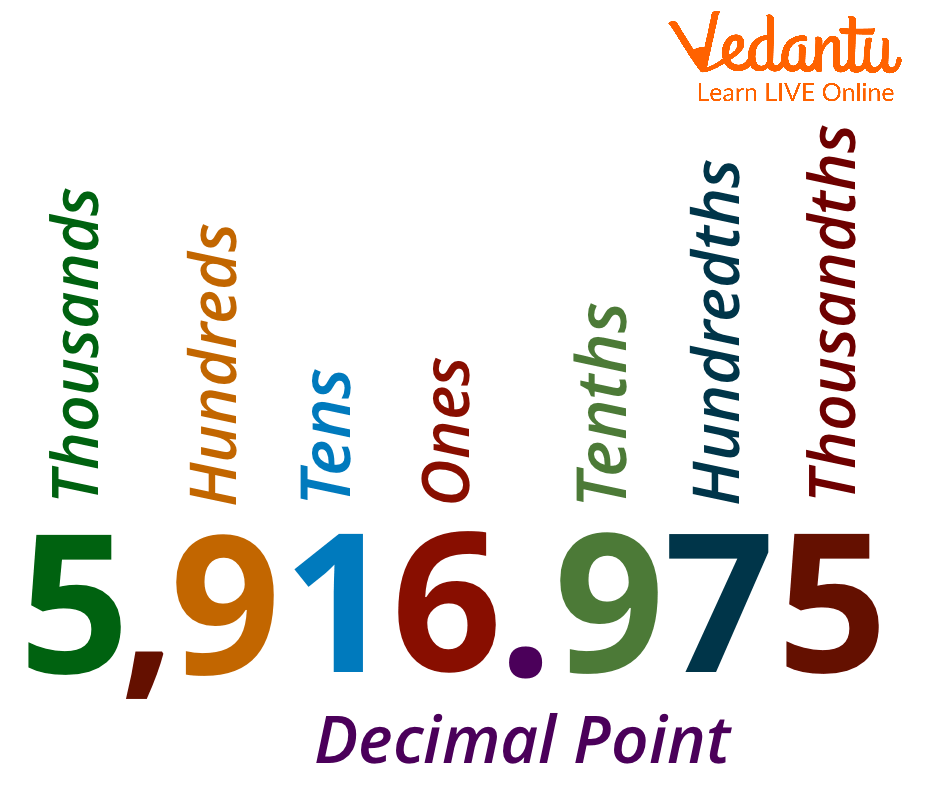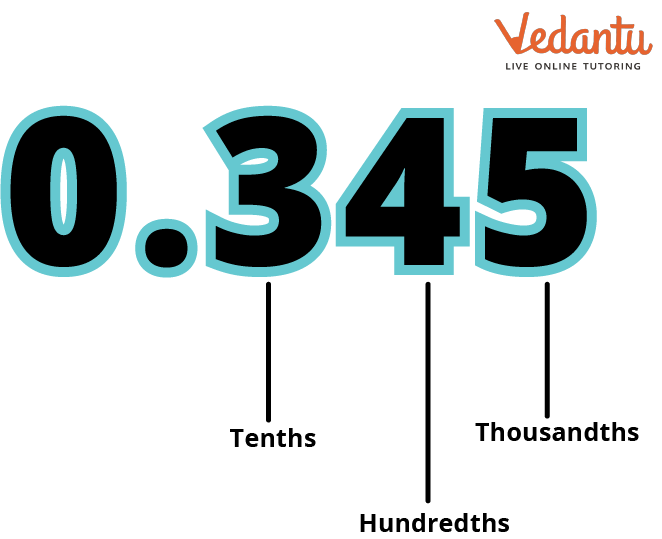




How to Identify and Use the Thousandth Decimal Place in Math Problems
Thousand, I hope you kids have heard of this word. You might have heard it from your parents, or teacher or while on your way to school or the park. It might have been used for a thousand rupees note or quantity many more. The fourth position to the left before the decimal point is at the thousands place value.
Whereas today we will learn about the thousandth place. The third position right after the decimal point is at the thousandth place value.
What is Place Value in Decimal?
A digit has a value called its place value depending where on its position in the number. A decimal point divides a decimal number into a whole number and a fractional part.
From these two statements, we can conclude that the digit's position in a number after the decimal point can be called the place value of a digit in decimal.

Place Value in Decimal
Thousandth Place in Decimal:
The thousandth place in decimals is the third numerical after the decimal.
One-thousandth is one part of the thousand parts or pieces. It does not start with ones. Instead, the number towards the right of the decimal is Tenths, the second digit after the decimal is Hundredths, and the third digit is called Thousandths.
For example, in 6.489 (SIX POINT FOUR EIGHT NINE),
4 (FOUR) is in Tenth place.
8 (EIGHT) is in the Hundredth place.
9 (NINE) is at the Thousandth place.

The Thousandth Place of 0.345
How to Convert the Decimal Fraction 0.825 into a Percentage
To convert a decimal number 0.825 into a percentage, follow the steps:
The first step is to multiply the decimal by 100.
Let's take the number 0.825
$ = \dfrac{825}{1000} \times 100 = 82.5$
The second step is to add the % (PERCENTAGE) sign to the value.
$ = 82.5\% $
Tenth, Hundredth, Thousandth - Chart
3 Decimal Places Example
The Thousandths place in place value means \[\dfrac{1}{{1000}}\] (ONE UPON THOUSAND). The Decimal number is a particular portion of the thousand. Let's take a look at some Thousandths place in decimals examples:
Example 1:
0.033 (ZERO POINT ZERO THREE THREE) is also represented as \[\dfrac{{33}}{{1000}}\] (THIRTY-THREE UPON THOUSAND) in fraction. It signifies that it is 33 over one thousand.
Example 2:
0.087 (ZERO POINT ZERO EIGHT SEVEN) is also represented as \[\dfrac{{87}}{{1000}}\] (EIGHTY-SEVEN UPON THOUSAND) in fraction. It signifies that it is 87 over one thousand.
Example 3:
0.002 (ZERO POINT ZERO ZERO TWO) is also represented as \[\dfrac{2}{{1000}}\] UPON THOUSAND) in fraction. It signifies that it is 2 over one thousand.
Conclusion
The value that a digit in a number represents depending upon its position is known as place value. The third position to the decimal's right is the thousandth place.
Now, that you guys know what we really mean by a thousandth. Then we can easily understand that if there are 1000 squares equal on a grid and if we spilt one of the squares into 10 equal squares, then one of such small squares will represent the thousandth, which is 1 over one thousand.
FAQs on Thousandth Place in Decimals: Meaning, Value & Examples
1. What is the thousandths place in a decimal number?
The thousandths place is the third digit to the right of the decimal point. It represents a fraction of one-thousandth (1/1000) of a whole. For example, in the decimal 0.123, the digit '3' is in the thousandths place.
2. Can you give an example of a number with a digit in the thousandths place?
Certainly. In the number 45.872, the digit 2 is in the thousandths place. This means the value of the digit is 2/1000 or two-thousandths.
3. How do you write 'five thousandths' as a decimal?
To write 'five thousandths' as a decimal, you place the digit 5 in the third position after the decimal point. Since there are no tenths or hundredths, you use zeros as placeholders. Therefore, five thousandths is written as 0.005.
4. How can you identify which digit is in the thousandths place in a number like 23.456?
To identify the digit in the thousandths place, you count the positions to the right of the decimal point.
- The first digit (4) is in the tenths place.
- The second digit (5) is in the hundredths place.
- The third digit (6) is in the thousandths place.
So, in 23.456, the digit 6 is in the thousandths place.
5. Why is understanding the thousandths place important in real life?
Understanding the thousandths place is crucial for activities requiring high precision. Examples include:
- Science and Engineering: Measuring tiny quantities in a lab or designing machine parts with exact dimensions.
- Finance: Calculating precise interest rates or stock market changes.
- Sports: Timing races, where winners are often decided by a thousandth of a second.
6. How does the thousandths place help in rounding a number to two decimal places?
The digit in the thousandths place is the key to rounding a number to the nearest hundredth (two decimal places). The rule is: if the digit in the thousandths place is 5 or greater, you round up the hundredths digit. If it is 4 or less, you leave the hundredths digit as it is. For example, 7.826 is rounded to 7.83 because 6 is greater than 5.
7. What is the value of 10 thousandths, and how does it relate to the hundredths place?
Ten thousandths (10/1000) is a crucial concept. As a fraction, 10/1000 can be simplified to 1/100. In decimal form, this is 0.01. This shows that 10 thousandths is exactly equal to 1 hundredth. It demonstrates how the decimal places are related by powers of ten.
8. What comes after the thousandths place in a decimal, and what is its value?
Immediately after the thousandths place comes the ten-thousandths place. This is the fourth digit to the right of the decimal point. Its value represents one ten-thousandth (1/10,000) of a whole. For example, in the number 0.1234, the digit '4' is in the ten-thousandths place.

















